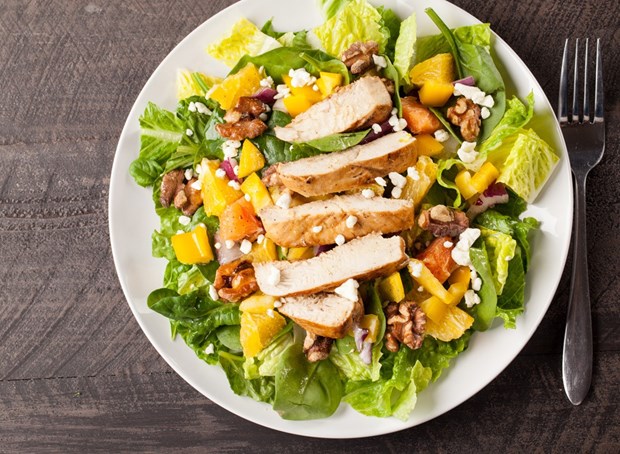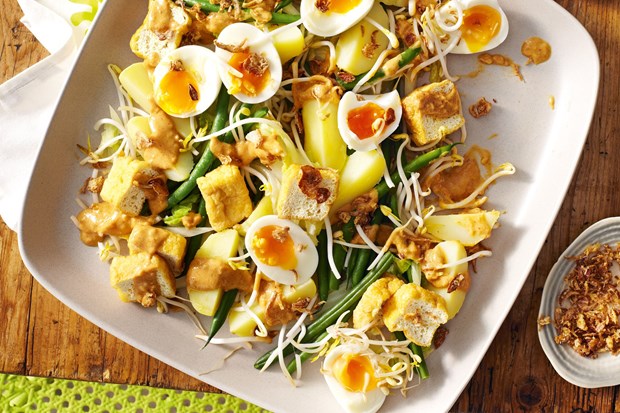From Italy to Indonesia, from Greece to California, have a look at our list of 12 salads from around the world and choose your favourite.
Good
salads from across the globe warrant attention: they're more than a diet food
made of iceberg lattuce and tomatoes. Let these twelve inspire you to toss your
way through the summer heat.
Peruvian solterito: From the region of Arequipa, Peru,
this salad (the name of which translates as “little single man”) consists of
potatoes, coriander, onion, rocoto chili pepper, fava beans, corn and quesillo
cheese. The ingredients are uniformly diced and bound in olive oil.
Californian Cobb
salad: The famous
Hollywood hangout, the Brown Derby, served a salad to its owner, Robert Howard
Cobb, who hadn’t eaten for hours. It was past midnight and he wanted something
filling but not too heavy, so he threw together various ingredients left in the
kitchen: grilled chicken, avocado, fried bacon, cheese, hardboiled eggs. Voilà,
the Cobb salad was born.
Tuscan panzanella salad: A cookbook could be written about
what to make with slightly stale bread. Not so stale that it turns blue, but
stale enough that you don’t want to eat it in the more traditional
bread-consumption manner. Tuscan panzanella is a cold salad of stale bread
cubes and soaked in olive oil, tomato, onion and salt. The bread makes it
filling enough to be a meal in itself, and the firmness of the bread gives it
nice crunch and absorption of all that delicious dressing.
Greek Horiatiki
salad: Onion,
tomato, cucumber, Kalamata olives and Feta cheese (served as a single block, not
cubed) is the traditional Greek salad, which is often called “village salad”
there. Head to the Dodacanese islands and you’ll find capers added. Go to a
traditional American “Greek diner” and it will be mixed with lettuce. In
whatever variation, it’s refreshing, cheap, and delicious.
Thai yum woon sen: Glass noodle salad is smothered in
a spicy dressing, taking the airy, bean thread noodles to another level. There
are peanuts, there’s the unctuous funk of dried shrimp, the perk of cilantro.
Fish sauce, lime, Thai chili. It’s a flavor party, but surprisingly light,
since the noodles themselves have just about no calories. Consider it the sort
of diet you’ll be delighted to be on!

American Caesar
salad: If there’s
one thing Americans love to order at restaurants, it’s a Caesar salad. But they
don’t want the traditional one. The one with anchovies. They want the one in
which the anchovy-ness is hidden in the dressing, and they want grilled chicken
on top. Historians seems to think that Cesare (Caesar) Cardini, born in 1896 in
Lago Maggiore, near Milano, was the man behind the salad. He moved to the US
after the First World War and lived in San Diego, but ran a restaurant in
Tijuana, Mexico, where the salad was first served. Lettuce, croutons, anchovies
were thrown together, the story goes, in 1924, when the restaurant, called
Caesar’s, was particularly busy. It was called the Aviator’s Salad, as Cesare’s
brother, Alex, had been a pilot with the Italian air force. In 1938 the
Cardinis moved to Los Angeles to open a restaurant, and the sauce for the salad
was bottled and sold from 1948 on. Anchovies are the key to the dressing,
adding an umami flavor that was strong, and is played down in the tamer modern
version that can be found on menus of just about every diner and bistro across
the US today.

Indonesian gado-gado: Salads are a good way of
deliciously disposing of ingredients that perhaps are not in such quantity as
to make a main, but which can provide good grace notes to a hybridized new
concoction. Whatever you’ve got in the larder? That’ll do for this “mix-mix”
salad, in which you might find exotic ingredients, like bitter gourd, chayote
and tempeh, but also spinach, hardboiled egg, torn bread, cucumber, cabbage…
whatever you’ve got, linked with a peanut dressing that forgives all
incongruities.
New York Waldorf
Salad: Chef Oscar
Tschirky of the Waldorf Hotel invented this unusual combination of grapes,
chopped apple, walnuts, celery and mayo on lettuce, the fame of which spread
far and wide.
Guatemalan fiambre: Straddling the line between salad
and potluck main course, this celebratory feast on a plate is traditionally
made on the Day of the Dead. The story goes that families would prepare
favorite dishes of deceased relatives on this special day, to honor them, and
eventually the various dishes were combined into a single, heaping plate that,
heck, we’ll call a salad. The exact recipe varies from family to family, but
you might find cold cuts, pickles, cheese, lettuce, sausages, salami, pacaya
flower, baby corn, hot peppers…it’s wonderfully anarchic.
Finnish rosolli: This beet salad is usually made at
Christmas, and it is beautiful and festive to look at, and to eat. Originating
in the wonderfully-name Hme region, its core is boiled beets, potatoes and
carrots, peeled and chopped. Then chopped gherkins and apples and onions are
added, usually layered in a glass bowl, to see the rainbow colors. The dressing
is whipped cream.
French Salade
Nicoise: Chunks of
tuna (not from a can, please), green beans (with the little “tails” clipped
off, please), eggs and potato form the core of this hearty salad celebrated in
Nice, on the French Riviera.
Slovenian salad: Alright, this salad might not be a
national dish, the way the others in this list are, but enough people I know in
Slovenia make a specific type of salad that I can consider it a “thing.”
Slovenian salad consists of lettuce, lots of chopped raw garlic, sliced boiled
potato, salt and vinegar. The garlic is brutally powerful. The other rival for
most-Slovenian of salads is made with the boiled beef leftover from making the
tradition Sunday beef noodle soup. That beef, when cold, is sliced and mixed
with sliced raw onion, salt, pepper, and vinegar.
By FDL